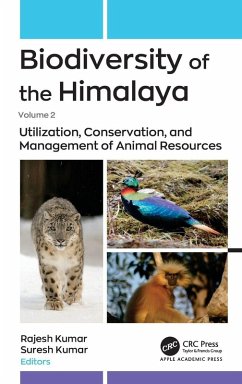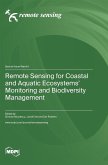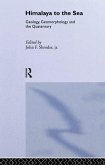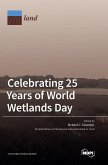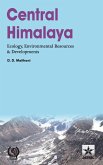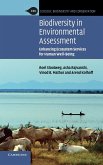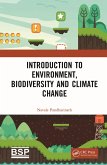Biodiversity of the Himalaya
Volume 2: Utilization, Conservation, and Management of Plant Resources
Herausgeber: Kumar, Rajesh; Kumar, Suresh
Biodiversity of the Himalaya
Volume 2: Utilization, Conservation, and Management of Plant Resources
Herausgeber: Kumar, Rajesh; Kumar, Suresh
- Gebundenes Buch
- Merkliste
- Auf die Merkliste
- Bewerten Bewerten
- Teilen
- Produkt teilen
- Produkterinnerung
- Produkterinnerung
Focuses on the utilization, conservation, and management of animal resources in the Himalayan region. Covers traditional knowledge of insects and animals for food and medicinal purposes. Discusses adverse changing climatic conditions, overuse of chemical and synthetic pesticides, eco-tourism, wildlife tourism, etc.
Andere Kunden interessierten sich auch für
![Remote Sensing for Coastal and Aquatic Ecosystems' Monitoring and Biodiversity Management Remote Sensing for Coastal and Aquatic Ecosystems' Monitoring and Biodiversity Management]() Remote Sensing for Coastal and Aquatic Ecosystems' Monitoring and Biodiversity Management92,99 €
Remote Sensing for Coastal and Aquatic Ecosystems' Monitoring and Biodiversity Management92,99 €![Biodiversity Biodiversity]() Shashikanth H MajagiBiodiversity36,99 €
Shashikanth H MajagiBiodiversity36,99 €![Himalaya to the Sea Himalaya to the Sea]() Himalaya to the Sea60,99 €
Himalaya to the Sea60,99 €![Celebrating 25 Years of World Wetlands Day Celebrating 25 Years of World Wetlands Day]() Celebrating 25 Years of World Wetlands Day80,99 €
Celebrating 25 Years of World Wetlands Day80,99 €![Central Himalaya Central Himalaya]() D D MaithaniCentral Himalaya46,99 €
D D MaithaniCentral Himalaya46,99 €![Biodiversity in Environmental Assessment Biodiversity in Environmental Assessment]() Roel SlootwegBiodiversity in Environmental Assessment132,99 €
Roel SlootwegBiodiversity in Environmental Assessment132,99 €![Introduction to Environment, Biodiversity and Climate Change Introduction to Environment, Biodiversity and Climate Change]() Navale PandharinathIntroduction to Environment, Biodiversity and Climate Change109,99 €
Navale PandharinathIntroduction to Environment, Biodiversity and Climate Change109,99 €-
-
-
Focuses on the utilization, conservation, and management of animal resources in the Himalayan region. Covers traditional knowledge of insects and animals for food and medicinal purposes. Discusses adverse changing climatic conditions, overuse of chemical and synthetic pesticides, eco-tourism, wildlife tourism, etc.
Produktdetails
- Produktdetails
- Verlag: Apple Academic Press
- Seitenzahl: 322
- Erscheinungstermin: 28. Oktober 2025
- Englisch
- Abmessung: 240mm x 161mm x 22mm
- Gewicht: 649g
- ISBN-13: 9781774919958
- ISBN-10: 1774919958
- Artikelnr.: 74778659
- Herstellerkennzeichnung
- Libri GmbH
- Europaallee 1
- 36244 Bad Hersfeld
- gpsr@libri.de
- Verlag: Apple Academic Press
- Seitenzahl: 322
- Erscheinungstermin: 28. Oktober 2025
- Englisch
- Abmessung: 240mm x 161mm x 22mm
- Gewicht: 649g
- ISBN-13: 9781774919958
- ISBN-10: 1774919958
- Artikelnr.: 74778659
- Herstellerkennzeichnung
- Libri GmbH
- Europaallee 1
- 36244 Bad Hersfeld
- gpsr@libri.de
Rajesh Kumar, PhD, is an Assistant Professor in the Department of Biosciences at Himachal Pradesh University, Summerhill, Shimla, India. With over 10 years of experience in teaching and research, Dr. Kumar has been teaching animal physiology and applied zoology to postgraduate students and also supervises PhD, MPhil, and MSc students for their research work. His own research activities also include environmental toxicology, waste management, and the impact of environmental degradation on animal physiology. He is an expert lecturer at beekeeping training/extension activities. Dr. Kumar has successfully completed two major research projects and two startup projects sponsored by government agencies and has published many research articles, book chapters, abstracts, and conference papers as well as several books and monographs. He has successfully organized about 20 seminars and conferences and delivered more than 30 invited talks and extension lectures in different institutions. He has received a fellowship for the year 2009-2011 from the University Grants Commission for working on honey/honeybees. He is a life member of the Indian Science Congress, National Bee Board, Applied Zoologists Research Association, and Society for Science & Environmental Excellence, and an affiliate member of the International Society of Zoological Sciences. Dr. Kumar is a fellow of Himalayan Science and Technology. He has earned 12 awards for his excellent research in honeybees/physiology to date. Dr. Kumar is also a reviewer of several journals of national and international repute. Dr. Kumar earned his master's degree and PhD in Zoology at Jiwaji University, India. Suresh Kumar, PhD, is presently working as an Associate Professor in the Department of Bio-Sciences, H.P. University, Shimla, India. He has more than 12 years of experience in teaching as well as research. His thrust areas include floristics, ethnobotany, and biodiversity. Dr. Kumar has published 10 books and more than 20 research papers in various journals of national and international repute. Presently, he has been guiding several students for their PhD degrees. He has participated in many conferences and seminars and has delivered invited talks as a resource person at various institutions. He is a member of the Indian Science Congress and many other scientific agencies. He is an associate editor as well as a reviewer for various journals in the field of botany. His work has received more than 250 Google Scholar citations; he has an h-index=7 and i10 index=6. He has qualified UGC-CSIR (NET) and completed his doctoral degree at H.P. University, Shimla, India, where he was awarded a Junior Research Fellowship for the period 2005-07 and a Senior Research Fellowship for the period 2007-09.
1. Indian Traditional Knowledge in Relation to Animal Origin Products with
Special Reference to Insects 2. The Himalayas: A Hotspot of Biodiversity 3.
Effect of Changing Climatic Conditions on Faunal Diversity of Northwestern
Himalaya 4. Impact of Chemical and Synthetic Pesticides on Himalayan Insect
Diversity 5. Impact of Anthropogenic Activities on Faunal Diversity of the
Snow-Covered Himalayan Range 6. Conservation Strategies for Threatened
Faunal Diversity of Himachal Pradesh 7. Eco-Tourism: Frenemy of Himalayan
Diversity 8. Effect of Invasive/Alien Animal Species in the Himalayan
Faunal System 9. Impact of Mobile Tower Radiation on Himalayan Fauna 10.
Socio-Economic Evaluation of Insect Products with Special Reference to
Himalayan Honeybees 11. Cordyceps militaris: An Entomopathogenic Fungus as
a Promising Solution for Conservation of Himalayan Cordyceps 12. Hunting,
Habitat Destruction, and Human Fun as Potential Threat to Himalayan
Diversity 13. Narpuh Wildlife Sanctuary, Meghalaya: Status, Challenges,
Sustainable Benefits and Future Perspectives
Special Reference to Insects 2. The Himalayas: A Hotspot of Biodiversity 3.
Effect of Changing Climatic Conditions on Faunal Diversity of Northwestern
Himalaya 4. Impact of Chemical and Synthetic Pesticides on Himalayan Insect
Diversity 5. Impact of Anthropogenic Activities on Faunal Diversity of the
Snow-Covered Himalayan Range 6. Conservation Strategies for Threatened
Faunal Diversity of Himachal Pradesh 7. Eco-Tourism: Frenemy of Himalayan
Diversity 8. Effect of Invasive/Alien Animal Species in the Himalayan
Faunal System 9. Impact of Mobile Tower Radiation on Himalayan Fauna 10.
Socio-Economic Evaluation of Insect Products with Special Reference to
Himalayan Honeybees 11. Cordyceps militaris: An Entomopathogenic Fungus as
a Promising Solution for Conservation of Himalayan Cordyceps 12. Hunting,
Habitat Destruction, and Human Fun as Potential Threat to Himalayan
Diversity 13. Narpuh Wildlife Sanctuary, Meghalaya: Status, Challenges,
Sustainable Benefits and Future Perspectives
1. Indian Traditional Knowledge in Relation to Animal Origin Products with
Special Reference to Insects 2. The Himalayas: A Hotspot of Biodiversity 3.
Effect of Changing Climatic Conditions on Faunal Diversity of Northwestern
Himalaya 4. Impact of Chemical and Synthetic Pesticides on Himalayan Insect
Diversity 5. Impact of Anthropogenic Activities on Faunal Diversity of the
Snow-Covered Himalayan Range 6. Conservation Strategies for Threatened
Faunal Diversity of Himachal Pradesh 7. Eco-Tourism: Frenemy of Himalayan
Diversity 8. Effect of Invasive/Alien Animal Species in the Himalayan
Faunal System 9. Impact of Mobile Tower Radiation on Himalayan Fauna 10.
Socio-Economic Evaluation of Insect Products with Special Reference to
Himalayan Honeybees 11. Cordyceps militaris: An Entomopathogenic Fungus as
a Promising Solution for Conservation of Himalayan Cordyceps 12. Hunting,
Habitat Destruction, and Human Fun as Potential Threat to Himalayan
Diversity 13. Narpuh Wildlife Sanctuary, Meghalaya: Status, Challenges,
Sustainable Benefits and Future Perspectives
Special Reference to Insects 2. The Himalayas: A Hotspot of Biodiversity 3.
Effect of Changing Climatic Conditions on Faunal Diversity of Northwestern
Himalaya 4. Impact of Chemical and Synthetic Pesticides on Himalayan Insect
Diversity 5. Impact of Anthropogenic Activities on Faunal Diversity of the
Snow-Covered Himalayan Range 6. Conservation Strategies for Threatened
Faunal Diversity of Himachal Pradesh 7. Eco-Tourism: Frenemy of Himalayan
Diversity 8. Effect of Invasive/Alien Animal Species in the Himalayan
Faunal System 9. Impact of Mobile Tower Radiation on Himalayan Fauna 10.
Socio-Economic Evaluation of Insect Products with Special Reference to
Himalayan Honeybees 11. Cordyceps militaris: An Entomopathogenic Fungus as
a Promising Solution for Conservation of Himalayan Cordyceps 12. Hunting,
Habitat Destruction, and Human Fun as Potential Threat to Himalayan
Diversity 13. Narpuh Wildlife Sanctuary, Meghalaya: Status, Challenges,
Sustainable Benefits and Future Perspectives

